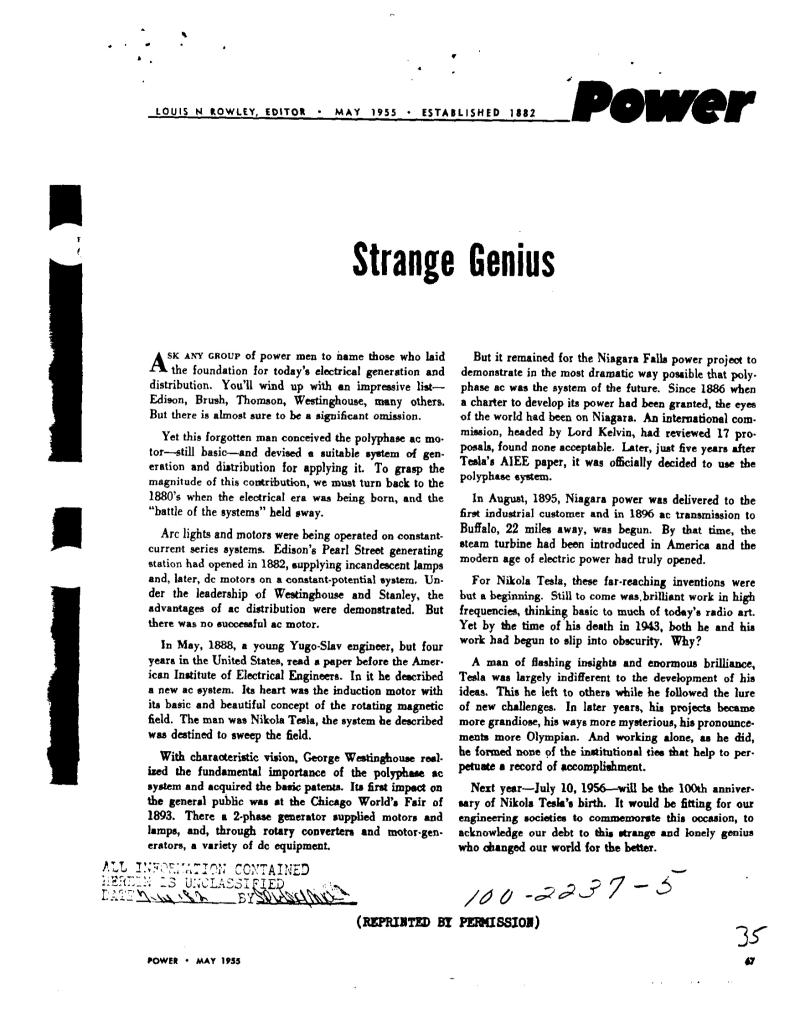
Nikola Tesla Documents
Nikola Tesla FBI Files - Page 35
LOUIS N ROWLEY, EDITOR MAY 1955 ESTABLISHED 1882 A SK ANY GROUP of power men to name those who laid the foundation for today's electrical generation and distribution. You'll wind up with an impressive list Edison, Brush, Thomson, Westinghouse, many others. But there is almost sure to be a significant omission. Strange Genius Yet this forgotten man conceived the polyphase ac mo. tor-still basic-and devised a suitable system of generation and distribution for applying it. To grasp the magnitude of this contribution, we must turn back to the 1880's when the electrical era was being born, and the "battle of the systems" held sway. Arc lights and motors were being operated on constantcurrent series systems. Edison's Pearl Street generating station had opened in 1882, supplying incandescent lamps and, later, de motors on a constant-potential system. Under the leadership of Westinghouse and Stanley, the advantages of ac distribution were demonstrated. But there was no successful ac motor. ALL INFORMATION CONTAINED HERDIN IS UNCLASSIFIED DARES BYS In May, 1888, a young Yugo-Slav engineer, but four years in the United States, read a paper before the American Institute of Electrical Engineers. In it he described a new ac system. Its heart was the induction motor with its basic and beautiful concept of the rotating magnetic field. The man was Nikola Tesla, the system he described was destined to sweep the field. POWER. MAY 1955 With characteristic vision, George Westinghouse real. ized the fundamental importance of the polyphase ac system and acquired the basic patents. Its first impact on the general public was at the Chicago World's Fair of 1893. There a 2-phase generator supplied motors and lamps, and, through rotary converters and motor-generators, a variety of de equipment. Power But it remained for the Niagara Falls power project to demonstrate in the most dramatic way possible that poly. phase ac was the system of the future. Since 1886 when a charter to develop its power had been granted, the eyes of the world had been on Niagara. An international commission, headed by Lord Kelvin, had reviewed 17 proposals, found none acceptable. Later, just five years after Tesla's AIEE paper, it was officially decided to use the polyphase system. In August, 1895, Niagara power was delivered to the first industrial customer and in 1896 ac transmission to Buffalo, 22 miles away, was begun. By that time, the steam turbine had been introduced in America and the modern age of electric power had truly opened. For Nikola Tesla, these far-reaching inventions were but a beginning. Still to come was, brilliant work in high frequencies, thinking basic to much of today's radio art. Yet by the time of his death in 1943, both he and his work had begun to slip into obscurity. Why? A man of flashing insights and enormous brilliance, Tesla was largely indifferent to the development of his ideas. This he left to others while he followed the lure of new challenges. In later years, his projects became more grandiose, his ways more mysterious, his pronouncements more Olympian. And working alone, as he did, he formed none of the institutional ties that help to per. petuate a record of accomplishment. Next year-July 10, 1956-will be the 100th anniversary of Nikola Tesla's birth. It would be fitting for our engineering societies to commemorate this occasion, to acknowledge our debt to this strange and lonely genius who changed our world for the better. 100-2237-5 (REPRINTED BY PERMISSION) 35
